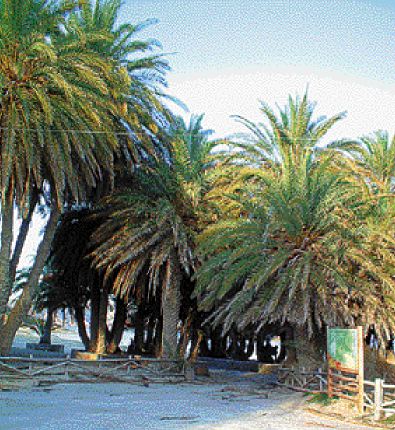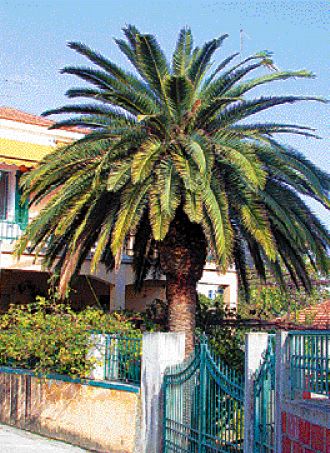 |
|
|
Palm Beach By Jennifer Gay |
|
|
THERE are only two palms native to Europe. One of them is the Dwarf Fan Palm, Chamaerops humilis (Hamiropas, Finikas Nanos) which is found growing along the seaboard of the Iberian peninsula. The other is the Vai Palm or Cretan Palm (Phoenix theophrastii), once widespread in Crete and the southern Peloponnese but now reduced to a handful of locations in Crete, the Aegean and southwest Turkey. The most famous of these sites is Vai in northeastern Crete, where this beautiful tree forms a proper palm grove, growing along a |
 Vai Palms |
|
narrow valley close to the sea, extending some distance along the beach. Until the 50s a substantial palm forest remained of some 300 hectares (3,000 stremmata) but in 1957 extensive land reclamation took place and most of the forest was destroyed. A paltry 16 hectares was all that remained. The beach was discovered by hippies in the 70s and developed into a longterm campers' paradise in the 80s. Unfortunately, a serious rubbish problem ensued until eventually the Vai Palm forest was declared a protected area, camping was forbidden and the beach was fenced, with entrance only permitted during daylight hours.
An EU LIFE project was set up to try and reverse the sad decline and increase the size of this unique forest - the only palm forest, after all, in Europe. Until a few years ago the forest remained hemmed in by agricultural activities which limited its natural regeneration. The Municipality of Itanos, the Greek Biotope and Wetland Centre, the local Toplou Monastery and the Forestry Directorate of Lasithi combined forces to persuade local stakeholders to swap about 9 hectares of land bordering the forest for agricultural plots further away. The monastery's involvement was pivotal because it donated the land next to the forest for replanting and land exchange so that over time the forest could be extended. The Toplou Monastery used to own most of the 26 hectares which make up the NE peninsula of Crete on which the Vai Palm forest is situated. Several years ago the monastery sold the leasehold to the Minoan Group (formerly Loyalward), which recently got the go-ahead to develop five holiday villages and three golf courses on the peninsula. Minoan Group say they are committed to safeguarding and extending the palm forest in conjunction with other interested parties. The EU project has so far almost doubled the area of palm trees from 16 hectares to 32 hectares. The young palm trees have a very slow growth rate - the trunk only becomes visible above ground after three of four years, thus vigilance with weeding is necessary to give the palms their best chance. The palms were regularly irrigated during the early years but were gradually weaned off this support to encourage the roots to look for their own water underground, and develop drought resistance. It was only in 1967 that the Swiss botanist Werner Greuter recognised Phoenix theophrasti as a separate species from the Date Palm, Phoenix dactylifera, and until now there is debate as to whether it should be classified as a subspecies of the Date Palm. It seems only natural that Greuter should have chosen to name the Cretan Palm after the botanist Theophrastus (372-287BC), who mentions it several times in On Natural History. It should also not be confused with the widely planted Canary Island Palm (Phoenix canariensis). Though all three frequently hybridise, several features distinguish the true species P theophrasti from both of these other species. Cretan Palm is a smaller palm with slender stems rarely reaching above 10 metres (the Date Palm may reach a towering 30 metres while Canary Palm is often 20m) and its leaves are more glaucous than either Canary Island Palm or Date Palm; the tips of the leaflets are also very sharp, and it is not advisable to plant it where people may brush past. It has also has an attractive tendency to sucker, creating magnificent multi-stemmed trunks, though one single parent stem usually dominates. The ripe fruit is dark brown and considered too small and fibrous to be worth eating, quite unlike the succulent fruits of the Date Palm - but locals do apparently partake sometimes. |
|
|
|
 Canary Island Palms |
|
give them good drainage and plenty of sun. Unlike most plants, the best time to transplant them is early summer - they need plenty of warmth to encour-age new root growth. |
|
|
Flowering now |
 |
| blue skies. February is early for Tree Spurge to flower (like just about everything else this year), usually blooming in March and April. A shrub of around 2-3 metres, it generally grows up to about 400 metres above sea level. Totally drought-resistant, it is summer deciduous, the leaves dropping to reveal an interesting, rather rounded branch structure. The leaves colour up beautifully in early summer, in oranges, reds and purple, reminiscent of a mini autumn display. Quite a mystery that this plant has not been adopted by the nursery trade, it is easily grown in well-drained soil. |
|
|
Gardener's query |
|
(Posting date 26 March 2007) HCS readers can view other excellent articles by this writer in the News & Issues and other sections of our extensive, permanent archives at the URL http://www.helleniccomserve.com./contents.html. The author is a journalist and writer for the English-language Athens News. Readers enjoying this article may wish to view other fine selections or to subscribe to this publication by visiting the website http://www.athensnews.gr. All articles of Athens News appearing on HCS have been reprinted with permission. |
|
|
|
|
2000 © Hellenic Communication Service, L.L.C. All Rights Reserved. http://www.HellenicComServe.com |
|
